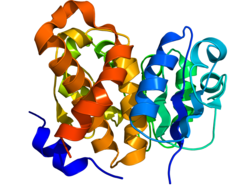Biology:CARKD
 Generic protein structure example |
| Carbohydrate kinase | |||||||||||
|---|---|---|---|---|---|---|---|---|---|---|---|
 Crystallographic structure of a putative Bacillus subtilis carbohydrate kinase (rainbow colored, N-terminus = blue, C-terminus = red).[1] | |||||||||||
| Identifiers | |||||||||||
| Symbol | Carb_kinase | ||||||||||
| Pfam | PF01256 | ||||||||||
| Pfam clan | CL0118 | ||||||||||
| InterPro | IPR000631 | ||||||||||
| PROSITE | PDOC00806 | ||||||||||
| SCOP2 | 1kyh / SCOPe / SUPFAM | ||||||||||
| |||||||||||
Carbohydrate kinase domain containing protein (abbreviated as CARKD), encoded by CARKD gene, is a human protein of unknown function. The CARKD gene encodes proteins with a predicted mitochondrial propeptide (mCARKD), a signal peptide (spCARKD) or neither of them (cCARKD). Confocal microscopy analysis of transfected CHO (Chinese-hamster ovary) cells indicated that cCARKD remains in the cytosol, whereas mCARKD and spCARKD are targeted to the mitochondria and the endoplasmic reticulum respectively.[2] The protein is conserved throughout many species, and has predicted orthologs through eukaryotes, bacteria, and archea.
Structure
Gene
Human CARKD gene has 10 exons and resides on Chromosome 13 at q34. The following genes are near CARKD on the chromosome:[3]
- COL4A2: A2 Subunit of type IV collagen
- RAB20: Potential regulator of Connexin 43 trafficking.
- CARS2: Mitochondrial Cystienyl-tRNA Synthetase 2
- ING1: Tumor-Suppressor Protein
Protein
This protein is part of the phosphomethylpyrimidine kinase: ribokinase / pfkB superfamily. This family is characterized by the presence of a domain shared by the family.[4] CARKD contains a carbohydrate kinase domain (Pfam PF01256).[4] This family is related to Pfam PF02210 and Pfam PF00294 implying that it also is a carbohydrate kinase.
Predicted properties
The following properties of CARKD were predicted using bioinformatic analysis:
- Molecular Weight: 41.4 KDal[5]
- Isoelectric point: 9.377[6]
- CARKD orthologs have highly variable isoelectric points.[6]
- Post-translational modification: Three post-translational modifications are predicted:
- Modified Phosphotyrosine Residue[7]
- Two N-Linked Glycosylation Sites[7]
- A Signal Peptide and signal peptide cleavage site was predicted.[8]
Function
Tissue distribution
CARKD appears to be ubiquitously expressed at high levels. Expression data in the human protein, and the mouse ortholog, indicate its expression in almost all tissues.[9][10] One peculiar expression pattern of CARKD is its differential expression through the development of oligodendrocytes. Its expression is lower in oligodendrocyte progenitor cells than in mature oligodendrocytes.[11]
Binding partners
The human protein apolipoprotein A-1 binding precursor (APOA1BP) was predicted to be a binding partner for CARKD.[12] This prediction is based on co-occurrence across genomes and co-expression. In addition to these data, the orthologs of CARKD in E. coli contain a domain similar to APOA1BP. This indicates that the two proteins are likely to have originated from a common evolutionary ancestor and, according to Rosetta stone analysis theory,[13] are likely interaction partners even in species such as humans where the two proteins are not produced as a single polypeptide.
Clinical significance
Based on allele-specific expression of CARKD, CARKD may play a role in acute lymphoblastic leukemia.[14] In addition, microarray data indicates that CARKD is up-regulated in Glioblastoma multiforme tumors.[15]
References
- ↑ PDB: 1kyh; "Structure of Bacillus subtilis YXKO--a member of the UPF0031 family and a putative kinase". Journal of Structural Biology 139 (3): 161–70. September 2002. doi:10.1016/S1047-8477(02)00532-4. PMID 12457846.
- ↑ Marbaix, AY; Tyteca, D; Niehaus, TD; Hanson, AD; Linster, CL; Van Schaftingen, E (15 May 2014). "Occurrence and subcellular distribution of the NADPHX repair system in mammals.". The Biochemical Journal 460 (1): 49–58. doi:10.1042/bj20131482. PMID 24611804.
- ↑ "UCSC Genome Browser: CARKD". http://genome.ucsc.edu/cgi-bin/hgTracks?position=chr13:110066009-110090343&hgsid=130989312&refGene=pack&hgFind.matches=NM_018210,.
- ↑ 4.0 4.1 "CDD: Conserved Domain Database (NCBI)". https://www.ncbi.nlm.nih.gov/sites/entrez?itool=gene_full_report&DbFrom=gene&Cmd=Link&LinkName=gene_cdd&IdsFromResult=55739.
- ↑ "Methods and algorithms for statistical analysis of protein sequences". Proceedings of the National Academy of Sciences of the United States of America 89 (6): 2002–6. March 1992. doi:10.1073/pnas.89.6.2002. PMID 1549558. Bibcode: 1992PNAS...89.2002B.
- ↑ 6.0 6.1 "PI Program (Isoelectric Point Prediction)". http://www.embl-heidelberg.de/cgi/pi-wrapper.pl.
- ↑ 7.0 7.1 "UniProt Database". https://www.uniprot.org/uniprot/Q8IW45.
- ↑ "Improved prediction of signal peptides: SignalP 3.0". Journal of Molecular Biology 340 (4): 783–95. July 2004. doi:10.1016/j.jmb.2004.05.028. PMID 15223320.
- ↑ "Unigene (EST profile viewer) Human CARKD". https://www.ncbi.nlm.nih.gov/UniGene/ESTProfileViewer.cgi?uglist=Hs.408324.
- ↑ "Unigene (EST profile viewer) Mouse CARKD". https://www.ncbi.nlm.nih.gov/UniGene/ESTProfileViewer.cgi?uglist=Mm.64911.
- ↑ "Identification of a novel oligodendrocyte cell adhesion protein using gene expression profiling". Journal of Neuroscience 26 (39): 9881–91. September 2006. doi:10.1523/JNEUROSCI.2246-06.2006. PMID 17005852.
- ↑ "STRING: Known and Predicted Protein-Protein Interactions". http://string.embl.de/.
- ↑ "The Rosetta stone method". Bioinformatics. Methods in Molecular Biology. 453. 2008. pp. 169–80. doi:10.1007/978-1-60327-429-6_7. ISBN 978-1-60327-428-9.
- ↑ "Allele-specific gene expression patterns in primary leukemic cells reveal regulation of gene expression by CpG site methylation". Genome Research 19 (1): 1–11. January 2009. doi:10.1101/gr.083931.108. PMID 18997001.
- ↑ "Identification of novel candidate target genes in amplicons of Glioblastoma multiforme tumors detected by expression and CGH microarray profiling". Molecular Cancer 5 (1): 39. 2006. doi:10.1186/1476-4598-5-39. PMID 17002787.
External links
- Human CARKD genome location and CARKD gene details page in the UCSC Genome Browser.

